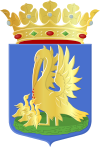Work of Nazareth
The work of Nazareth ( en . : Work of Nazareth ; es . : Obra de Nazaret ; it . : Opera di Nàzaret ; abbreviation: ODN ) is an association of believers in the Roman Catholic Church . The Nazareth plant is also known as the “Movimento di Compagnia”. It was initiated in 1964 and received its current name in 1976, and in 1999 it received papal recognition. The plant has 500 members spread across 17 countries around the world.
history
The first plant was founded in 1964 as a children's and youth recreational facility in Reggio nell'Emilia ( Italy ); it included adolescents who were about to enter adulthood. Her spiritual father was Professor Giovanni Riva († 2012), who recognized the need for young adults to receive adequate training and a meaningful assignment. Under his care the youth group grew into a Christian-spiritual community . Since 1976 the community has been called "Opera di Nàzaret", at the same time spouses gathered in the ODN and it expanded beyond the borders of Italy. In 1989 the work was episcopally and canonically recognized by Archbishop Ernesto Cardinal Corripio y Ahumada of Mexico City . This was followed on August 15, 1999 by the Pontifical Council for the Laity as an association of believers under papal law and entry into the official register .
Self-image
“Be disposed towards one another as it corresponds to life in Christ: He was equal to God but did not cling to being like God. But he emptied himself and became like a slave and like men. His life was that of a person. "
This passage from Paul's letter to the Philippians characterizes the spirituality and charisma of the ODN, because it is convinced that man is less man without Jesus Christ . From this develops the main goal that Christ is the mediator of the Father and can never be separated from the calling of man. Everyday spiritual life therefore includes prayer , apostolic , charitable and missionary training, the implementation of missionary activities and the further development of Christian education .
logo
The logo of the ODN shows a person sitting in the nest pelicans with two young birds, the swan injured on the front of his chest and out dripping blood is taken from the young swans. This religious symbol is intended to make it clear that Jesus Christ gave his own blood to people.
Organization and expansion
In its organizational structure , the ODN allows every member to have direct contact with the presidential center. Geographically, the organization is divided into country groups and diocesan groups, whereby the groups may also set up sub-groups. Members of any nationality can become adults , they work in regional and local groups. The members have the opportunity to bind themselves to the work in a special way, including making a religious promise and following the evangelical counsels . The training takes place in regular meetings and aims to deepen the doctrine of the Church .
The ODN has 500 members living in 17 countries around the world, and another 5,000 people participate in the work's lay apostolate . The following institutions are directly affiliated with the ODN: "The Great Company", an association of educators ; “The Others”, an association of students and “Le Domus”, a family association that offers youth accommodation.
literature
- The Spiritual Communities of the Catholic Church - Compendium (No. 98, Werk von Nazareth, pp. 276–278), St. Benno-Verlag , Leipzig , 204, ISBN 3-7462-1995-7
Web links
- Pontifical Council for the Laity: Work of Nazareth (multilingual)
- Pope Urges Association 'Work of Nazareth' to Continue With Joy Vatican City, August 21, 2014 (Zenit.org)
- Story about the "Work of Nazareth" (Italian)
Individual evidence
- ^ Obituary for Prof. Giovanni Riva: Il professor Giovanni Riva è tornato alla casa del Padre [1]
- ↑ See also: Pelicans in Iconography , Flag of Louisiana and Coat of Arms of Etgersleben
- ↑ Hymn “ Adoro te devote ”: “O good pelican, o Jesus, greatest good! Wash my unclean heart with your precious blood. A single drop creates the whole earth anew, washes all sinners clean, frees everyone from debt "
